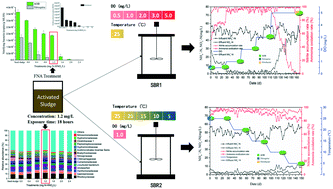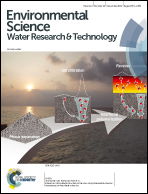Comprehensive assessment of free nitrous acid-based technology to establish partial nitrification†
Abstract
Treating activated sludge with free nitrous acid (FNA) to selectively eliminate nitrite-oxidizing bacteria (NOB) and retain ammonium-oxidizing bacteria (AOB) is increasingly regarded as a promising technology for achieving partial nitrification. This study provided a comprehensive assessment of this technology based on optimal FNA treatment conditions, functional microbial community response, and resistibility of established partial nitrification to high dissolved oxygen (DO) concentration and low temperature. An FNA concentration of 1.2 mg HNO2-N per L and an exposure time of 18 hours were found to be the most effective conditions to simultaneously inactivate NOB completely and maintain an AOB activity of 56.76%. Under these conditions, no damaging side effects on the functional microbial community were observed except for the NOB groups being substantially reduced. The results of inoculating two 10 L SBRs with FNA-treated sludge and operating them under different DO concentrations and temperatures showed that stable partial nitrification could be maintained at a DO concentration as high as 3.0 mg L−1 and temperature as low as 5 °C. However, vigorous multiplication of NOB, especially Nitrobacter, caused destruction of the partial nitrification after long-term operation under a DO concentration of 5.0 mg L−1. Although stable partial nitrification was not destroyed by low temperature, the ammonia oxidation rate was impaired.


 Please wait while we load your content...
Please wait while we load your content...